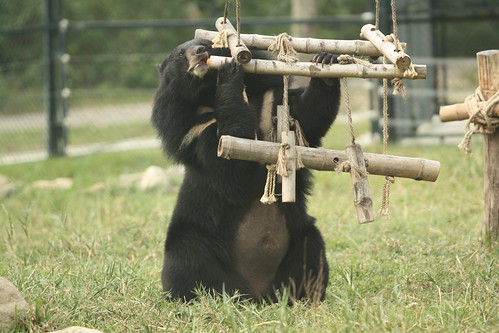Bear necessities part two: The bear food balancing act
09 April 2014
In the second part of our look at bear diets we focus on how caring for food-led animals can mean a tricky balancing act for their keepers.
With bears on the scales every three months – their weight is more carefully monitored than most humans. Underweight or overweight – either can cause concern but it’s often not as simple as simply increasing or decreasing the amount of food available.
For bears that would not naturally live in social groups of up to 20 in the wild – group management throws up its own challenges and food is a large part of that.
Their healthy sanctuary diet is augmented with daily exercise. The bears at our Chengdu sanctuary are free to roam, swim and climb over a large outdoor area. Their food is scattered and placed strategically throughout the enclosures to encourage natural behaviour and stimulate them both mentally and physically
Nic Field, Bear and Vet Team Director at our China sanctuary described the balancing act that her team are presented with:
“The weight of the bears is a constant challenge for us managing them in groups which is why we weigh all bears every three months and some more often. It is rather a balance. Considering the health issues these bears have like arthritis and mobility issues, obviously being over-weight does not help but at the same time as we manage bears in groups we need to consider that they are a resource driven species and we want to avoid food competition and aggression. We also need to consider the seasonal fluctuations in their appetites. The other thing is that we place food and enrichment in the enclosures to promote physical and mental stimulation"
For the team, monitoring of bears to spot whose weight is above or below their ideal, is an on-going task. To complicate this further, weight can also fluctuate season by season.
Bear Manager Heidi Quine says:
“Seasonal weight changes must be taken into consideration when determining food quantities and food types. For example in autumn, bears will seek out high calorie foods in preparation for winter dormancy, so we include the likes of chestnuts and peanuts in their diet. Bear appetites are assessed using a range of indicators. Eating speed, individual bear noise and aggression over food have proven to be reliable gauges of hunger or satisfied appetites. Feed amounts are adjusted weekly, although daily or immediate adjustments are possible if required.”
Managing bears year on year and monitoring them accordingly means the Animals Asia team can call on an unrivalled knowledge of bear care. It’s an expertise that continues to grow and it ensures the quality of care is in a state of constant improvement.
BACK






 5 reasons the dog meat trade must end
5 reasons the dog meat trade must end
 New year, new home for Christmas the Bear!
New year, new home for Christmas the Bear!
 Veterinary welfare training – pain management
Veterinary welfare training – pain management